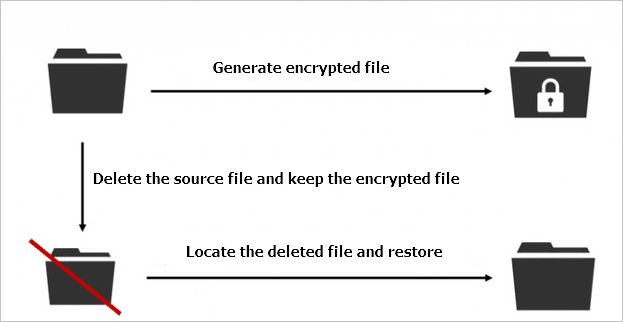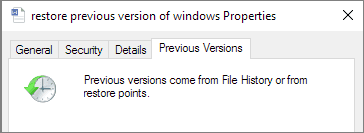How to Recover Ransomware Encrypted Files
Quick Navigation: Recover Ransomware Encrypted and Deleted Files
There are many solutions to restore encrypted files by ransomware attacks. We have selected some easy-to-implement approaches for you. Read to see details.
| Workable Solutions | Step-by-step Troubleshooting |
|---|---|
| 1. Use Data Recovery Software | Run Qiling virus file recovery software on your Windows PC. Select the correct drive according...Full steps |
| 2. Restore from a System Backup | Go to Control Panel, click "System and Security" > "Backup and Restore" > "Restore files from backup"...Full steps |
| 3. Restore from Previous Versions | Locate the directory where the data is stored. Right-click the file, then select "Properties"...Full steps |
| 4. Run Ransomware Decryption Tools | Click the downloaded file at the bottom left corner of your screen...Full steps |
Ransomware Overview
The ransomware virus is a new and advanced type of computer virus that mainly spreads in the form of mail, program Trojans, and web pages. The virus is terrible and extremely harmful. It uses various encryption algorithms to infect, delete, and encrypt files.
The ransomware transmits in three major ways: vulnerability, mail, and advertising. Once your computer and any other storage device are infected by a ransomware virus, like the notorious ones Locky, Zcrypt, CryptoLocker, CryptWall, TorrentLocker, etc., you can't access the infected files or system until you pay the ransom.
We advise you not to pay for the ransom. Moreover, even if you have made the payment, your data may not be intact like before, and you may face a greater data risk. Hence, after the infection, you can try some ways to recover ransomware encrypted files quickly. In the following parts, we will show you a few practical methods to recover data.
Method 1. Use Professional Virus Attack Data Recovery Software
Before the data recovery, you can look at the workflow of most ransomware.

As you can see from the graphic, the encryption files created by ransomware are not the original files but only copies. The original files are not encrypted directly but deleted by the virus. Therefore, you can use a data recovery tool to restore the removed source files. As long as the data recovery software finds the deleted source files, there is a possibility of recovery.
Try Deep Data Recovery as the first attempt. It's a reputable file recovery software that can recover files infected by the Locky virus, such as CryptoLocker and other ransomware viruses.
Try Qiling Data Recovery Software
- Recover lost or deleted files, documents, photos, audio, music, emails effectively
- Recover files from formatted hard drive, emptied recycle bin, memory card, flash drive, digital camera, and camcorders
- Support data recovery for sudden deletion, formatting, hard drive corruption, virus attack, system crash under different situations
Step 1. Choose file types and click "Next" to start
Run Qiling virus file recovery software on your Windows PC. Choose file types and click "Next" to start.

Step 2. Select the virus infected drive to scan
Select the disk attacked by the virus to scan for lost or hidden files. Note that:
- If it's an HDD where files were hidden or deleted by virus, it's better to install the software on a different volume or an external USB drive to avoid data overwriting.
- If the infected device is an external hard drive, flash drive or memory card, it doesn't matter to install the software on the local drive of the computer.

Step 3. Check all scanned results
Deep Data Recovery will immediately start a scan process to find your deleted or hidden files on the virus infected hard drive. To quickly locate the wanted files, you can use the Filter or type grouping feature to display only the pictures, videos, documents, emails, etc.

Step 4. Preview and recover deleted/hidden files
When the process finishes, you can preview the scanned files. Select the files you want and click the "Recover" button. You should save restored files to another secure location on your computer or storage device, not where they were lost.
The ransomware is constantly changing. Some new and more advanced viruses may work differently from what shown above. They may not delete the source file so that the data recovery software won't be helpful. However, we still strongly recommend that you use a file recovery tool to retrieve the data once infected. Although we cannot make sure about the virus type, we must make the data recovery timely by all available means.
Method 2. Restore from a System Backup
If the data recovery program isn't workable and you happen to create a system backup, you can try to recover virus-infected files using Windows backup. You can recover data from worse scenarios in this way. Therefore, setting up Automatic Windows Backup is a useful way to prevent data loss.
Go to Control Panel, click "System and Security" > "Backup and Restore" > "Restore files from backup". In the Backup and Restore screen, click "Restore my files" and follow the wizard to restore your files

Method 3. Restore from Previous Versions
The previous version of the file also can help you to recover encrypted files by ransomware.
1. Locate the directory where the data is stored. Right-click the file, then select "Properties".
2. Click the "Previous Versions" tab when the Properties window opens.
Note: If you don't see the Previous Versions tab, you need to install the client. You can speak with your support team to get the correct client installed.
3. A list of available snapshots for the file will appear. Select the snapshot that represents the last known good version of the file.
4. Click "View" and verify if it is the correct version of the file. Once you find the right file, do any of the following:
- View: View the recovered file directly and then save it by clicking "File" > "Save As".
- Copy: Create a copy of the recovered file in the same directory as the original file. You will now have both copies available.
- Restore: This will restore the recovered file and will replace the current file.
Important: Restoring the file will overwrite the current copy. Any data saved in the present copy will be overwritten with the older file.

Method 4. Run Free Ransomware Decryption Tools
Many computers can be infected with ransomware and unlocked by them. You can just download the free ransomware decrypt tool called Avast, which can help decrypt files encrypted by ransomware.
Step 1. Click the downloaded file at the bottom left corner of your screen.
Step 2. Click "Yes" on the system dialog window to approve the start of your Avast installation.
Step 3. Click the button in the installer window to begin the installation. Then, solve the ransomware error with Avast.

Wrap Up
Ransomware can attack both individuals & enterprises. To minimize losses, you should act instantly and use effective methods to get files back. You can try any of the above methods to recover ransomware encrypted files. However, most users don't enable the file or system backup feature on their computers. So you need to use a data recovery program, like Deep Data Recovery, to restore files. As one of the leading data recovery products, it's famous for deleted files recovery, virus attack recovery, formatted recovery, recycle bin emptied data recovery, lost partition recovery, and more. It also provides you with the free version for a trial. Have a try, and it won't let down.
How to Prevent Virus Attack Effectively
Prevention is easier than rescue. You can try the following tips to protect your computer from infecting viruses.
- Do not open emails' attachments or links sent by unknown senders.
- Install and enable the anti-virus software on your computer. Besides, remember to upgrade it at any time.
- Use required software to download online files, do not double-click to open the .js, .vbs, and other suffix files.
- Regularly back up important data and files on your computer. If you don't want to copy data manually, you can use professional schedule backup software for automatic backup.
- Report the ransomware attack as it is an illegal cybercrime.
Related Articles
- Recover Deleted Chrome Downloads and Resume Canceled Chrome Downloads
- How to Restore Missing Desktop Icons and Files in Windows 10/11
- My Documents Folder Missing from Windows 10/11 [Fixed Here]
- How to Recover Unsaved Word Document 2019/2018/2016/2013/2010/2007